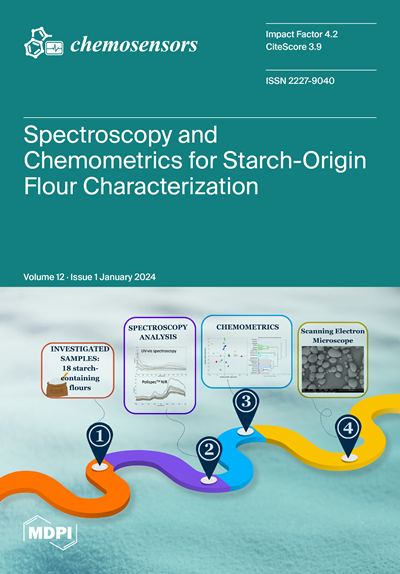带碳纳米壁的高灵敏度 H2 和 CH4 声表面波传感器及其等离子处理后的性能改进
IF 3.7
3区 工程技术
Q2 CHEMISTRY, ANALYTICAL
引用次数: 0
摘要
我们开发出了在室温(RT)下具有高灵敏度和可逆响应的表面声波(SAW)传感器。传感器的敏感区域由垂直排列的石墨烯片制备而成,就像沉积在石英声表面波传感器基底上的碳纳米墙(CNWs)。碳纳米管是在 600 °C 下通过射频等离子体增强化学气相沉积(PECVD)获得的,随后通过氢等离子体处理提高了其灵敏度。SAW 传感器在 0.02% 至 0.1% 的浓度范围内对 H2 和 CH4 进行了测试,结果表明这两种气体都具有可逆响应,检测限为几个 ppm。根据扫描电子显微镜(SEM)的观察,额外的氢等离子体处理保留了层状结构,CNW 边缘的形态略有改变。X 射线光电子能谱(XPS)研究显示,处理后存在新的官能团、大量缺陷和电子跃迁。氯化萘表面化学状态的变化很可能是等离子处理后气体吸附性提高的原因。这些结果表明,氯化萘表面活性剂是设计新型声表面波传感器的一种有前途的材料,有可能利用等离子处理将检测限提高到 ppm 级以下。本文章由计算机程序翻译,如有差异,请以英文原文为准。
High-Sensitivity H2 and CH4 SAW Sensors with Carbon Nanowalls and Improvement in Their Performance after Plasma Treatment
We have developed surface acoustic wave (SAW) sensors with high sensitivity and a reversible response at room temperature (RT). The sensitive area of the sensor was prepared from vertically aligned graphene sheets, like carbon nanowalls (CNWs), which were deposited onto the quartz SAW sensor substrate. The CNWs were obtained by RF plasma-enhanced chemical vapor deposition (PECVD) at 600 °C, and their sensitivity was subsequently enhanced through hydrogen plasma treatment. The SAW sensors were tested at H2 and CH4 at RT, and they exhibited a reversible response for both gases at concentrations between 0.02% and 0.1%, with a detection limit of a few ppm. The additional hydrogen plasma treatment preserved the lamellar structure, with slight modifications to the morphology of CNW edges, as observed by scanning electron microscopy (SEM). X-ray photoelectron spectroscopy (XPS) investigations revealed the presence of new functional groups, a significant number of defects and electron transitions after the treatment. Changes in the chemical state on the CNW surface are most probably responsible for the improved gas adsorption after plasma treatment. These results identify CNWs as a promising material for designing new SAW sensors, with the possibility of using plasma treatments to enhance the detection limit below the ppm level.
求助全文
通过发布文献求助,成功后即可免费获取论文全文。
去求助
来源期刊

Chemosensors
Chemistry-Analytical Chemistry
CiteScore
5.00
自引率
9.50%
发文量
450
审稿时长
11 weeks
期刊介绍:
Chemosensors (ISSN 2227-9040; CODEN: CHEMO9) is an international, scientific, open access journal on the science and technology of chemical sensors published quarterly online by MDPI.The journal is indexed in Scopus, SCIE (Web of Science), CAPlus / SciFinder, Inspec, Engineering Village and other databases.
 求助内容:
求助内容: 应助结果提醒方式:
应助结果提醒方式:


